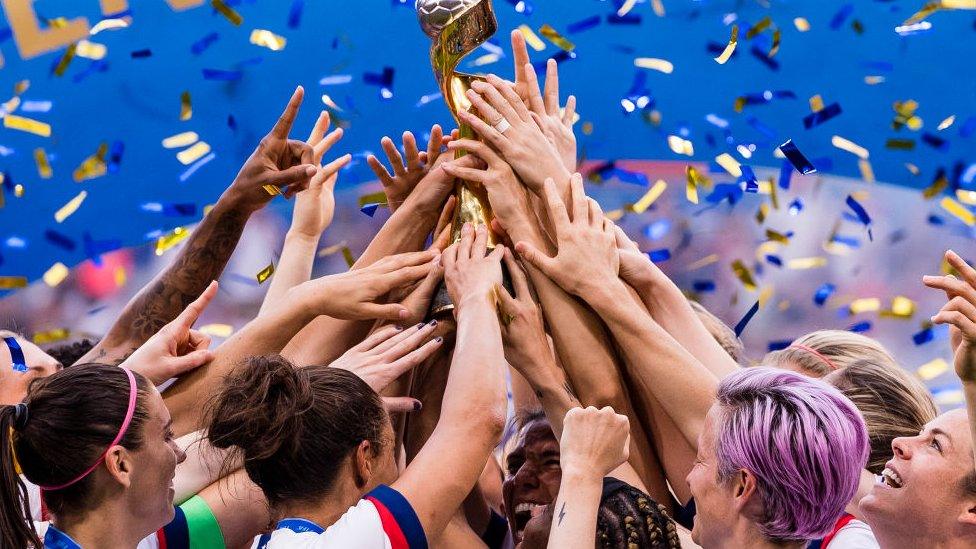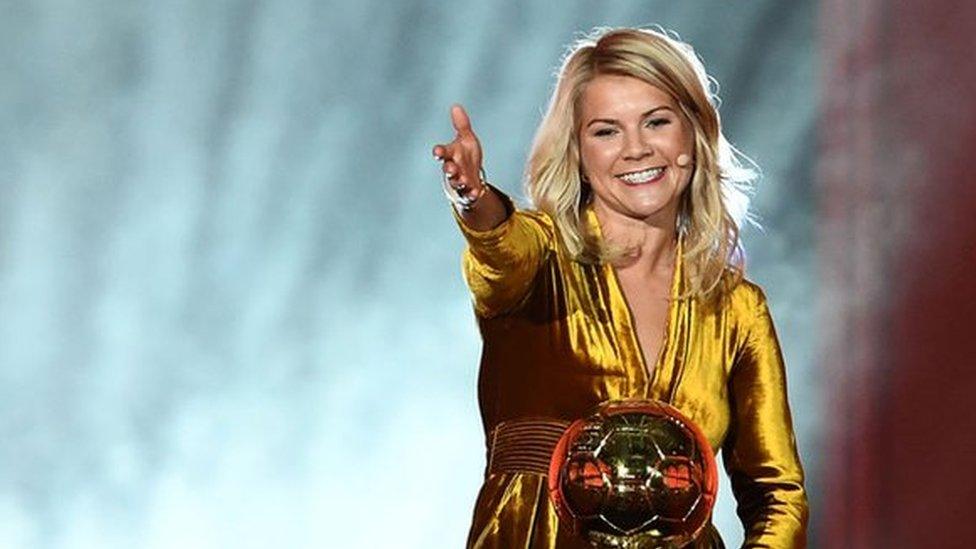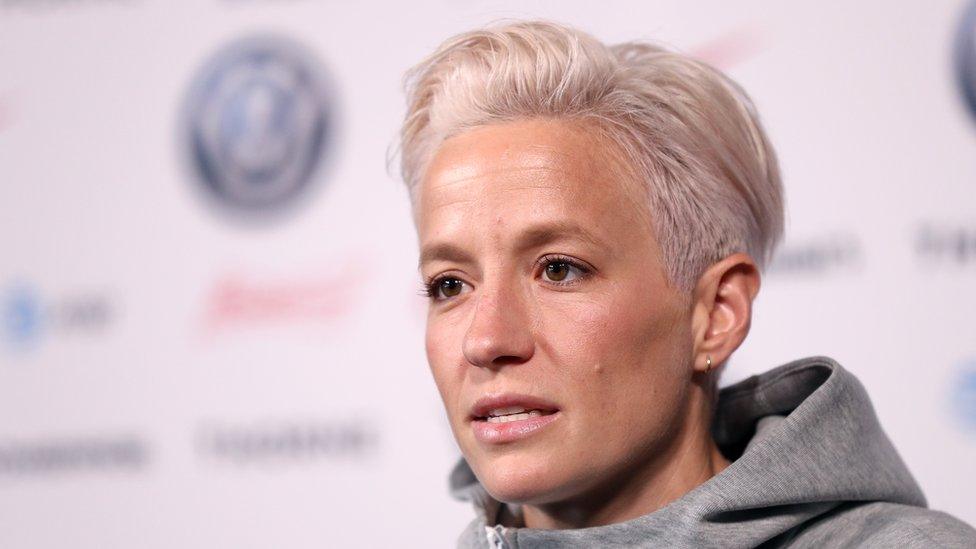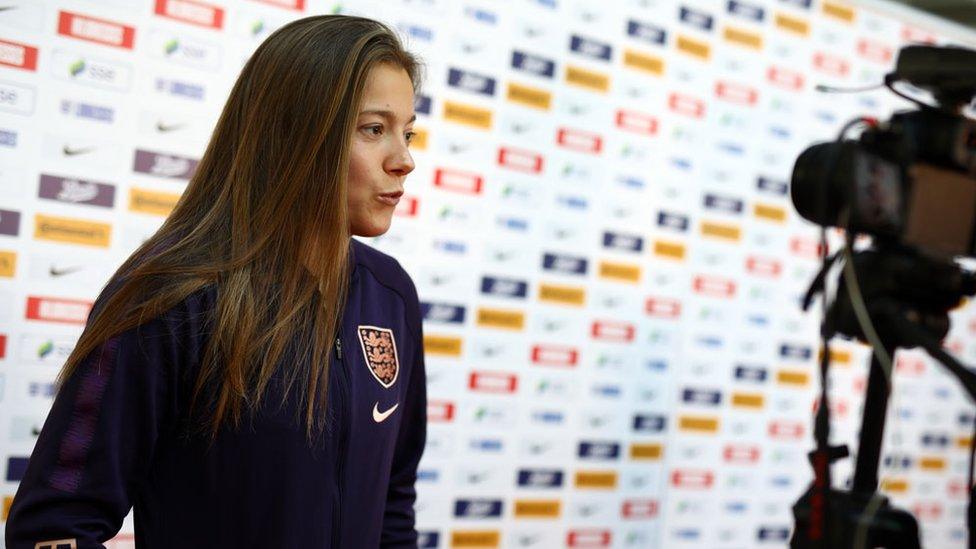Women's World Cup: What is the pay gap?
- Published

The US women's team, victorious at the World Cup, have taken legal action in America demanding equal pay
Demands for equal pay in football have grown louder following the successful staging of the Women's World Cup tournament in France.
With the US team triumphant, the crowd in the stadium chanted: "Equal pay! Equal pay!"
"I think we are done with the questions like 'are we worth it?', 'should we have equal pay?'," American star player Megan Rapinoe said after the game. "Let's get to the next point of 'what's next?'."
Reality Check has taken a look at the prize money awarded at the men's and women's World Cups, and how that money is distributed.
Allow X content?
This article contains content provided by X. We ask for your permission before anything is loaded, as they may be using cookies and other technologies. You may want to read X’s cookie policy, external and privacy policy, external before accepting. To view this content choose ‘accept and continue’.
How is prize money awarded?
The winning US team in France received $4m (£3.2m), double the amount of the previous tournament in 2015.
The prize money given to other teams depended on how far they got, starting at $750,000 (£590,000) for taking part in the initial group stage.
In total, Fifa awarded $30m (£24m) to the competing teams in the women's tournament.
For last year's men's World Cup, the total prize money awarded was $400m (£315m), more than ten times as much.

Ballon d'Or winner Ada Hegerberg was not in the Norwegian squad after stepping away from international football in 2017 over gender equality issues
On top of prize money, each women's team received a little over $800,000 for preparation costs and club compensation. The men's teams last year each received $1.5m.
It's frequently argued that this is linked to the difference in revenue generated by the men's and women's events.
However, Fifa says commercial revenues from the Women's World Cup cannot be separated out from other Fifa competitions, as rights are often sold as a package.
Women's football on the rise
Do players get all the prize money?
Fifa gives the prize money not to team members but to the national federations, which can choose how much to give to the players and how much to invest in other areas of the game.
These arrangements are generally agreed with the players' unions and not revealed publicly.
The Australian women's team said it had bargained for a 30% cut of any eventual prize money.
Other football associations we spoke to were unwilling to discuss specific financial matters.
"At the end of the day, the prize money ends up being so small for the women compared to the men, that we see players relying more on sponsorships, club salaries or federation salaries," says Caitlin Murray, author of a book on the history of the US women's team.

US star Megan Rapinoe said there has long been a lack of investment and care in the women's game
According to the world players' union, Fifpro, women footballers in western Europe might earn a monthly salary from their clubs of perhaps €1,000-2,000 and an allowance of €50-100 per day from their national FA when they are on duty with the national team. The very top players would earn more.
Players in poorer countries may receive very little payment from their national associations.

Fifa's position is that the organisation is making significant progress in encouraging the women's game.
Prize money "is only a small part of the investments Fifa is doing for the development of women's football around the entire world," says Sarai Baremen, its Chief Women's Football Officer.
Over the next three years, Fifa plans to invest $400m-$500m directly into the women's game.
Its last financial report showed that the organisation spent $28m on women's football promotion.

England star Fran Kirby says the team "need to win the World Cup" before talking about equal pay
Demanding a fairer deal
In the United States, the women's team have taken legal action against the national football association over equal pay issues.
The Australian players' union has called on Fifa to reward male and female players equally.
The Nigerian team staged a sit-in protest at a hotel in 2016 over outstanding payments, after winning the Women's Africa Cup of Nations.
A 2018 deal in New Zealand led to the men's and women's teams receiving the same payments and equal prize money, external while representing the national team.
In Norway in 2017, men and women started to receive the same pay for representing their country.
And the Dutch FA recently came to an agreement that will see commercial compensation for players grow, eventually aiming to match those of their male counterparts between 2021 and 2023.
Vivianne Miedema, on behalf of the Dutch players' council, said "we are very satisfied with the new agreements" which are a step "towards an equal appreciation for both men and women."


